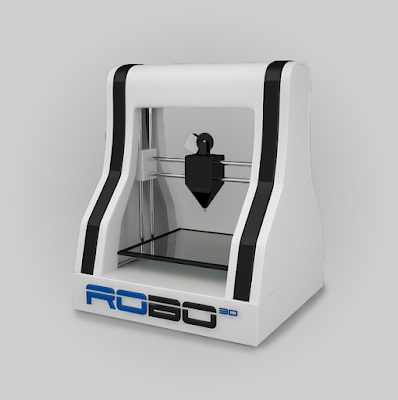Several weeks ago, I got into a conversation with Hight, the owner of Sinclair Games (our FLGS), about 3D printing. Which included showing him my previous post on the female ganger minis that I'd bought from Shapeways. He was pretty impressed and wanted to find out more about it.
Cue a couple of Wednesdays ago, when I walked into the store to see him playing with a brand new filament printer (The Robo 3d above) which cost him around $800 on Amazon. He was downloading terrain models from Thingverse and trying to figure out how best to print them. With mixed results, but much enthusiasm. He's fully on board now with the idea of 3D printing replacing traditional metal/resin miniature production. He's just frustrated at the lack of usable models out there.
But that's getting ready to change in some interesting ways...
3D Modular Gaming Terrain
This is the first KickStarter I've seen that is only offering digital models for the user to print. Not finished pieces that get shipped to you.
Beasts of War interviewed this guy, so skip ahead to 0:35 to see it in the next video:
Now, 28mm miniatures still require a high-resolution resin printer to look nice. But terrain is another matter. These buildings are all optimized for printing on a $500-ish filament printer. Plus they're designed to be re-scalable, and can work with both 28mm (40K), or 15mm (Flames of War) with no problem. Six mm (Epic 40K) might be a problem for some of them (but not if you use a Resin Printer).
Pay attention to the super-low per-piece printing costs he's talking about, and then realize that's in NZ dollars, so the US price would be around 40% lower.
Also note the thinner-than-resin-cast, but much stronger walls (because they're printed as one structural piece). Notice the details like working doors that are printed right into the model.
Now imagine your local game shop printing up this terrain and selling it for $10-15 per building. This kind of on-demand terrain is the first major commercial inroad that 3D printing is going to make into the gaming market.
I've backed it of course.
For $88 US, the max level is a complete steal. Plus, all he has to deliver to me is digital files to print with. So you have none of the manufacturing risks that have taken down projects like RoboTech RPG Tactics, or the iBox Nano. I'd expect to pay way more than $88 for any half-decent 3D file on a professional 3D site like TurboSquid.
Licensed To Copy
If you go back to the Beasts of War video above at 0:28:47, you'll note that one of the miniature products they review comes with an interesting set of options. For an additional price, you can purchase a personal, or a commercial license to copy that miniature as many times as you like.
While that's a casting license (because that's what makes sense for small minis right now), you're going to see miniatures go the same way as the above KickStarter eventually. Where individual designers sell you the files to print their minis, with either a low-cost personal IP license, or a higher-cost commercial license. Effectively outsourcing all production to other hobbyists/stores.
The competition that comes from that is going to create a serious downward pressure on miniature prices across the board. The miniature prints will still cost more to make than injection-molded plastic sprues, but there will be no assembly required, and the costs of injection-molded plastics will HAVE to come down to fall in line with the lower overall value that they provide.
That's gonna squeeze the profit margins of GW, Privateer, and especially Battlefront VERY hard.
The other big thing is going to be the sheer variety on offer. When talking about the Apocalypse Ruins KickStarter above, the Beasts of War guys noted that one of his stretch goals was a set of Aztec Ruins – something that you would never see mass-produced because it wouldn't appeal to enough people. But it's something that a designer can find a niche for and make money off of when production can be outsourced to your customers.
